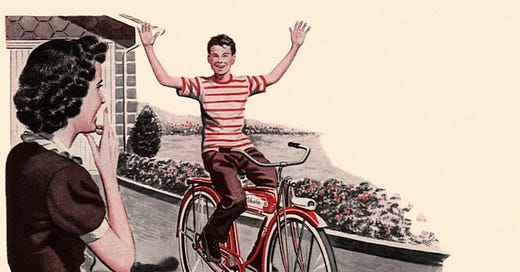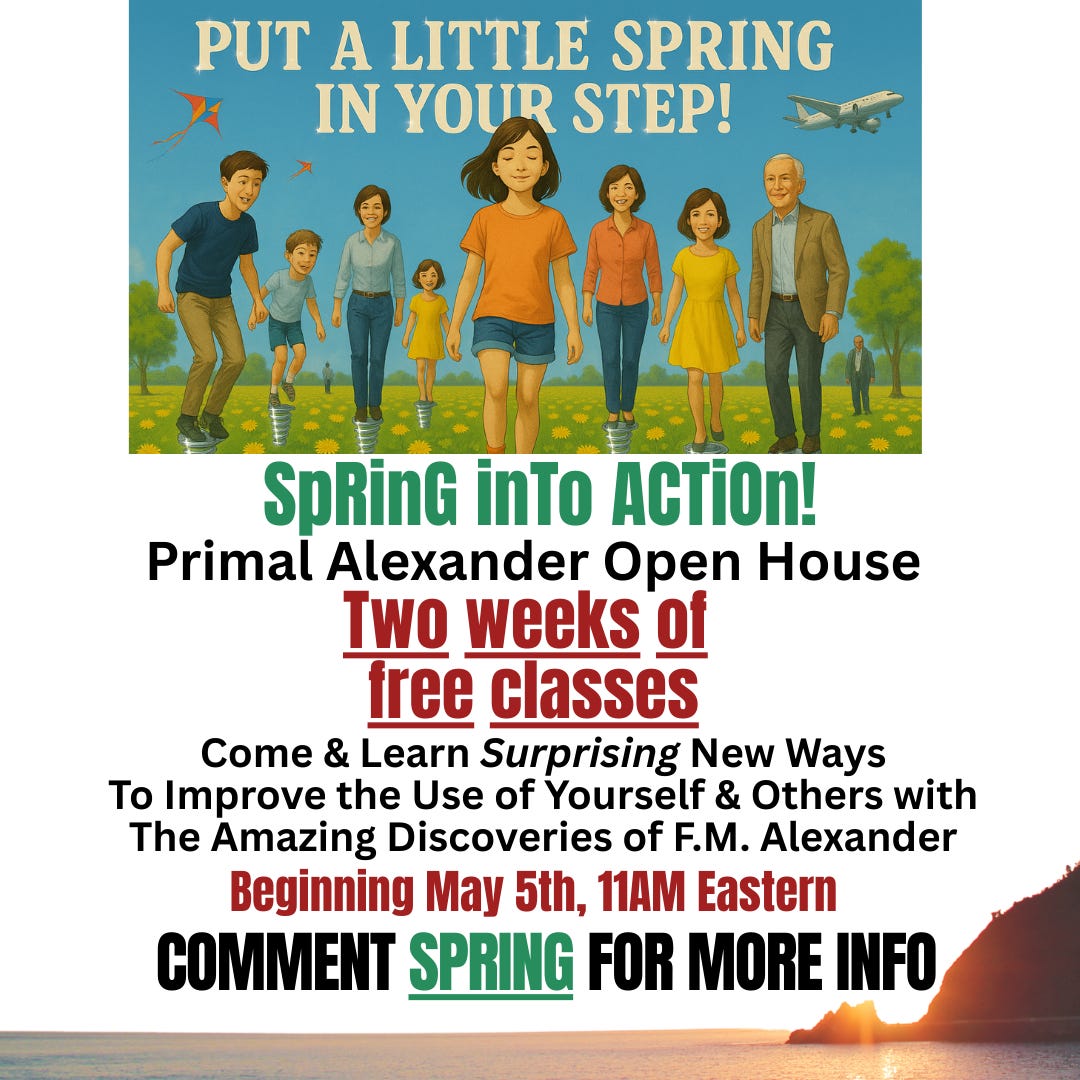Although hands-on kinesthetic guidance is not part of its approach, Primal Alexander (P.A.) is deeply rooted in the all the fundamental principles that underlie traditional Alexander Technique teaching.
Based loosely upon the kind of experimentation that Alexander used to solve his vocal problems, P.A. emphasizes self-discovery, efficient learning, and a straightforward approach that focuses on experimentation and student self-empowerment.
In this document I will explore the fundamental features of Primal Alexander as both a teaching and a learning method focusing on………………..
Core Principles of Primal Alexander
Several core principles underpin the Primal Alexander approach to teaching, learning, and perception.
1. Experimentation and Curiosity: The Engine of Learning
At the heart of Primal Alexander lies the emphasis on experimentation and curiosity as the primary drivers of learning and change. This mirrors F.M. Alexander’s own journey of discovery, which began with the awareness of a problem he wanted to solve, which then led to years of self-observation and trial-and-error to resolve his vocal issues.
Approximating Alexander’s Process: Primal Alexander aims to simulate the conditions that Alexander created for himself in order to make his discoveries. This involves encouraging students to adopt an inquisitive mindset and to actively experiment with their own patterns of thinking, movement and perception.
Shifting from Habitual Reaction: As in traditional Alexander Technique, the lynchpin of P.A. is Inhibition because unless the immediate reaction to a stimulus is prevented, positive change simply doesn’t happen. Primal Alexander asks students to pause, do some Constructive Thinking and then, while noticing the increase in Ease, begin the activity with an eye to seeing what happens to the experience of Ease they just created.
The Experimental Sequence: This Inhibition/Constructive Thinking/Experience/Curiosity sequence is at the heart of what jumpstarts the neurological changes that build new pathways that allow us move with more flexibility, power, awareness & Ease. The process itself also gives us agency and the belief that whenever problems do occur in the future, we will have the ability to solve them through our own conscious efforts.
Valuing the Process over Outcome: Primal Alexander also emphasizes that tremendous value is gained from the act of experimenting itself, not solely from achieving a desired outcome. This helps to reduce “end-gaining,” which is our tendency to fixate on a goal at the expense of process, often without our realizing it.
2. Constructive Thinking: Guiding the Experiment
Constructive thinking, also referred to as Curious Thinking, is a central tool in Primal Alexander for guiding the experimental process. It involves a conscious mental activity that precedes or accompanies movement, aimed at promoting ease and better coordination.
Focusing on Ease: A key aspect of constructive thinking in Primal Alexander is directing attention towards areas of relative ease in the body. This is contrasted with focusing on tension, which can exacerbate it. The prompt “Where else do I seem to be easing a bit?” is a foundational element of this practice.
The Power of Intention: After even minimal practice, the very the intent to engage in Constructive Thinking can initiate positive changes in the nervous system. This suggests that the conscious decision to be more aware and direct one’s attention towards places of relative ease raises the general level of Ease present which facilitates body’s overall coordination.
Beyond Intellectual Understanding: Primal Alexander recognizes that constructive thinking is not merely an intellectual exercise. The part of the mind that knows intellectually is not necessarily equipped to judge whether one is improving. Instead, it’s about first establishing and then observing what happens to an experience of ease that informs the process..
Integrating with Movement: Constructive thinking is intended to be integrated with movement, either preceding it or occurring simultaneously. However, there is a nuance that although simultaneous, constructive thinking actually comes first, influencing the subsequent movement.
3. The Primacy of Ease: A Guiding Experience
Noticing and cultivating ease is a central tenet of Primal Alexander learning and teaching. It serves as a key indicator of improved coordination and a guide for the experimental process.
Relative Ease: The focus is on finding places of relative ease in the body at any given moment, recognizing that some areas will always be easier than others.
Shifting Attention from Tension: Intentionally directing attention to ease is presented as a more effective strategy than focusing on tension, which can reinforce negative patterns.
Ease as Feedback: The experience of ease serves as a form of feedback, indicating that the constructive thinking is having a positive effect on the “whole mechanism”. Changes in Ease are essentially unpredictable and reveal improvements beyond conscious control.
Ease is actually a verb: It is essential that Ease be thought of as a ongoing process rather than a state to be maintained. Ease is best thought of as Easing: An action verb rather than a thing.
Every Little Bit is a lot!: Any increase in easing, no matter how small, is significant because it represents a neurological change in direction from reinforcing interference to reinforcing freedom and flexibility
Ease is More Global Than Local: Although Ease is, in the beginning, mostly experienced locally in a particular place, noticing ease in one part of the body can lead to wonderful and unexpected improvements in other areas, such as an increase in vocal expressiveness or an increase in the power and efficiency of an activity requiring speed or strength.
A New "Direction": Central to the effectiveness of Primal Alexander is a discovery I made about 35 years ago. Put simply, the act of noticing a place of relative ease in your body facilitates the head/neck reflex
Student Empowerment: Now, granted, the change is slight & almost unnoticeable at first, but the fact that they can do it themselves and that it can be taught to just about anybody in the first 15 minutes of their very 1st lesson opens up all kinds of new possibilities.
TO BE CONTINUED….Next: The Teacher’s Role: Guiding the Exploration
Also…
I’ll be holding a free Open House next month. If you comment SPRING below I’ll send you the details!





